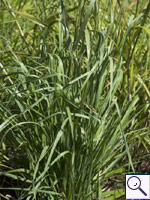|
||||||
|
BROMOPSIS. Bromes. [Poaceae] |
|
|
Five species of Bromopsis are recorded in Great Britain & Ireland These include the native Lesser Hairy-brome (B. benekenii), Upright Brome (B. erecta), Hungarian Brome (B. inermis, with two subspecies) and Hairy-brome (B. ramosa). The BSBI provide a downloadable plant crib for Bromopsis. Fourteen British miners are recorded on Bromopsis. Nearly 100 British miners or possible miners are recorded on grasses in Britain. A key to the European miners recorded on Bromus incluidng Bromopsis is provided in Bladmineerders van Europa. It is recommended that adults of all miners on grasses be reared to be certain of their identity. |
|
Key for the identification of the known mines of British |
Note: Diptera larvae may live in a corridor mine, a corridor-blotch mine, or a blotch mine, but never in a case, a rolled or folded leaf, a tentiform mine or sandwiched between two more or less circular leaf sections in later instars. Pupation never in a cocoon. All mining Diptera larvae are leg-less maggots without a head capsule (see examples). They never have thoracic or abdominal legs. They do not have chewing mouthparts, although they do have a characteristic cephalo-pharyngeal skeleton (see examples), usually visible internally through the body wall. The larvae lie on their sides within the mine and use their pick-like mouthparts to feed on plant tissue. In some corridor miners frass may lie in two rows on alternate sides of the mine. In order to vacate the mine the fully grown larva cuts an exit slit, which is usually semi-circular (see Liriomyza huidobrensis video). The pupa is formed within the hardened last larval skin or puparium and as a result sheaths enclosing head appendages, wings and legs are not visible externally (see examples). See Key to non-Diptera. |
1# > ? Leaf-miner: Details of mine and larva unknown. Because the adult fly closely resembles that of A. nigrella, possibly this applies as well to mine and larvae. Puparium dark brown |
|
Agromyza bromi Spencer, 1966 [Diptera: Agromyzidae]. |
1a > Leaf-miner: Broad elongated mine; the form is dependent of the leaf form of the host plant. Frass green. Usually a number of larvae together in a mine. Pupation in the mine. |
|
Cerodontha incisa (Meigen, 1830) [Diptera: Agromyzidae]. |
1b > Leaf-miner: Normally several larvae feed together. Pupation in the mine. Puparium shining black (Spencer, 1976: 198). Broad elongated blotch. Frass greenish. Larvae generally communal. Pupation within the mine. The black puaria are individially anchored within the mine with a silken thread attached at their rear end. Distinguishable from C. incisa only by means of the larva. |
|
Cerodontha pygmaea (Meigen, 1830) [Diptera: Agromyzidae]. |
1c > Leaf-miner: Long upper-surface corridor usually containing several larvae that graze shoulder to shoulder from the leaf tip downwards. Pupation outside the mine. Mines and larvae are indistinguishable from those of A. nigrella. |
|
Agromyza mobilis Meigen, 1830 [Diptera: Agromyzidae]. |
1d > Leaf-miner: Mine greenish with only single larva, initially running towards apex of leaf before turning back down and developing into a broad blotch. Puparium reddish brown. |
|
Agromyza rondensis Strobl, 1900 [Diptera: Agromyzidae]. |
| 1e > Leaf-miner: Larval
leaf-mine starts as a narrow channel running towards apex of leaf
but later develops into a broad blotch running downwards. Frass
largely diffused, giving the mine a characteristic greenish appearance.
Pupation external (Spencer, 1976:
126).
Corridor, usually several in one leaf, running from close to the leaf base up to near the tip, then reversing direction and widening, resulting in one communal mine in which the larvae descend in a common front. Frass somewhat deliquescent, mine therefore strikingly green. Pupation outside the mine. Neither mine nor larva distinguishable from those of mobilis. Puparium reddish brown |
|
Agromyza nigrella (Rondani, 1875) [Diptera: Agromyzidae]. |
1f > Leaf-miner: A narrow whitish linear mine, running down the leaf from the apex, with frass in two rows of separate grains. Pupation external (Spencer, 1976: 246). Narrow corridor from start to end, whitish, uppper- or lower-surface, genarally running downwards. Mine often along the leaf margin. Frass in distict grains of regular size, alternating along the sides of the corridor. Pupation outside the mine. |
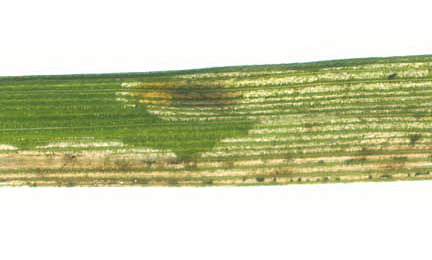 Mine of Liriomyza flaveola on Festuca gigantea Image: © Willis Ellis (Bladmineerders van Europa) |
|
Liriomyza flaveola (Fallén, 1823) [Diptera: Agromyzidae]. |
1g > Leaf-miner: Long, narrow, whitish mine. Pupation internal (Spencer, 1976: 453); anterior spiracles projecting through the epidermis. Whitish, upper-surface, rather narrow corridor with comparatively large frass grains that are laying further apart than their diameter. Pupation within the mine. The anterior spiracles of the orange-brown puparium penetrate the epidermis. |
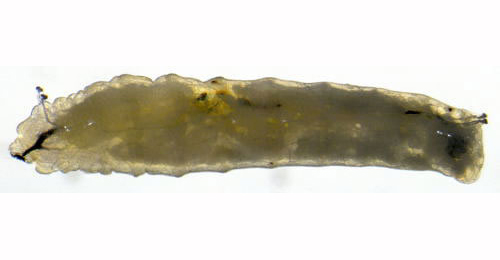 Chromatomyia nigra larva, lateral Image: © Willem Ellis (Bladmineerders van Europa) |
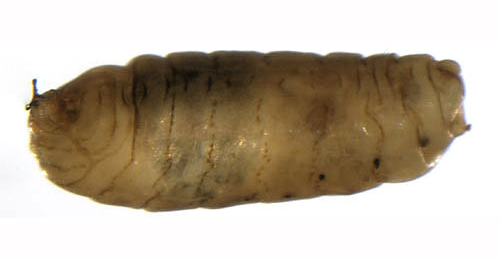 Chromatomyia nigra pupa, lateral Image: © Willem Ellis (Bladmineerders van Europa) |
|
Chromatomyia nigra (Meigen, 1830) [Diptera: Agromyzidae]. |
|
Key for the identification of the known mines of British |
Note: The larvae of mining Coleoptera, Hymenoptera and Lepidoptera may live in a corridor mine, a corridor-blotch mine, a blotch mine, a case, a rolled or folded leaf, a tentiform mine or sandwiched between two more or less circular leaf sections in later instars. Larva may pupate in a silk cocoon. The larva may have six legs (although they may be reduced or absent), a head capsule and chewing mouthparts with opposable mandibles (see video of a gracillarid larva feeding). Larvae of Hymenoptera and Lepidoptera usually also have abdominal legs (see examples). Frass, if present, never in two rows. Unless feeding externally from within a case the larva usually vacates the mine by chewing an exit hole. Pupa with visible head appendages, wings and legs which lie in sheaths (see examples). |
1a > Leaf-miner and case-bearer: The larva lives outside the mine, protected by a case, and feeds on the underlying plant tissues via a hole cut in the epidermis. From that point it eats away as much leaf tissue as it can reach without fully entering the mine. Mine does not contain frass (Coleophora species) |
1b > Leaf-miner, but not a case-bearer: The larva lives mainly inside the mine. Mine usually contains frass. In later instars the larva may live sandwiched between two more or less circular sections cut from the leaf. |
2 > Leaf-miner and case-bearer: The young larva eats the receptacle out of a floret of Acinos arvensis, and uses the calyce as its first case. Even before the onset of winter it switches to grasses. The larva then lives in an ochraceous, bivalved, tubular leaf case of c. 9 mm, with a mouth angle of c. 25°. The case is illustrated in British Leafminers. |
|
Coleophora tricolor Walsingham, 1899 [ Lepidoptera: Coleophoridae]. |
3a > Leaf-miner: A small narrow mine on a wide variety of grasses. In the spring the larva changes leaves and mines tip downwards. The mine fills the leaf width. The frass is packed in the top of the mine. In autumn the larva makes a narrow corridor a few cm in length, in which it hibernates. In March it moves to a new leaf. Here a transparent, full depth mine is made that descends from the leaf tip, and occupies the entire width of the blade. Most frass is concentrated in the oldest, highest, part of the mine. The larva may leave its mine and restart elsewhere. Pupation outside the mine. |
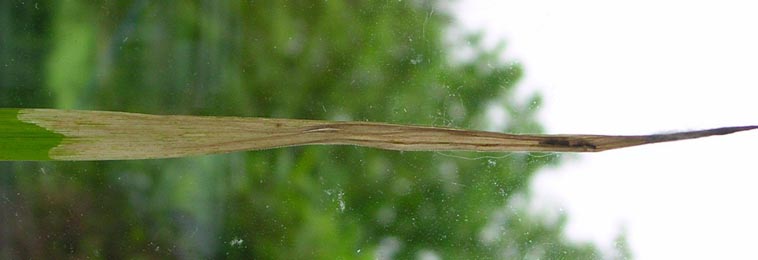 Mine of Elachista argentella on Dactylis glomerata Image: © Ben Smart (British leafminers) |
|
Elachista argentella (Clerck, 1759) [Lepidoptera: Elachistidae]. |
3b > Leaf-miner: Gradually widening mine in the base of the blade; the sides very irregulary scalloped out. In the end the blade may be eaten out completely. When lit from behind the mine is not uniformly transparant, but rather yellowish green and mottled because the larva leaves parts of the leaf tissue uneaten, and does not feed full depth. Pupation external. |
|
Elachista cingillella (Herrich-Schäffer, 1855) [Lepidoptera: Elachistidae]. |
3c > Leaf-miner: Long, narrow, white corridor, descending from close to the leaf tip to the leaf base or even stem. Frass in an inconspicuous grey line. From the stem the larva may enter a new leaf (Steuer, 1987a; Bland, 1996a). |
|
Elachista luticomella Zeller, 1839 [Lepidoptera: Elachistidae]. |
3d > Leaf-miner: Initially a narrow brownish mine with blackish frass at its base, then moves to another leaf, forming a broader mine. Both mines can pucker the blade. |
|
Elachista obliquella Stainton, 1858 [Lepidoptera: Elachistidae]. |
3e > Leaf-miner: Narrow, flat, corridor descending from the leaf tip. Frass in an almost continuous line. The larva usually makes several mines. Mines pale yellow green at first, turning purple later. Pupation external. |
|
Elachista subnigrella Douglas, 1853 [Lepidoptera: Elachistidae]. |
3f > Leaf-miner and Stem-borer: The first instar lave mines in a leaf; after that it lives as a stem borer. |
|
Ochsenheimeria vacculella Fischer von Röslerstamm, 1842 [Lepidoptera: Ypsolophidae]. |
| Last updated 01-Jul-2019 Brian Pitkin | ||

